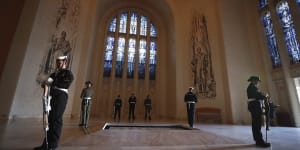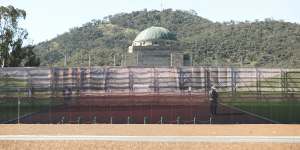It would be a cold heart that was not affected by a few hours spent wandering the echoing halls of the Australian War Memorial,surrounded by the ghosts of 102,800 Australians whose lives were taken by conflict over the past century and a bit.

The Tomb of the Unknown Soldier within the Australian War Memorial in Canberra.Alex Ellinghausen
The essence - some might say the soul - of the place for almost 30 years now is the Hall of Memory. Within lies the tomb of an unknown soldier. No one speaks in there. The silence is too loud.
On November 11,1993,I heard the prime minister,Paul Keating,deliver one of the,welcoming home this unnamed soldier,his remains brought from a cemetery on the World War I killing fields of the Western Front in France.
“He is all of them,” Keating said of the anonymous soldier,referring to the columns of those lost to wars. “And he is one of us.”
Here,surely,is the meaning of this great building:a permanent memorial to those Australians who suffered and died a long way from home,a place of reflection and memory,and perhaps something of a salve to the hundreds of thousands who came home,their nerves and bodies shot to hell.
Much of the remainder of the big building is given over to a museum-like collection of relics from wars,works of art and rooms set aside for the education of the huge numbers of students and others who visit each year,plus a great archive and research centre.
And yet,something fundamental has always been absent.
No part of it is dedicated to the first of Australia’s wars:those fought as the original inhabitants,the peoples of the First Nations,tried to resist the overwhelming force of Europeans lusting for their land. In Australia’s war memorial,the Frontier Wars,and those uncounted thousands who suffered and died,receive no memorial.
Right now,however,the memorial sits surrounded by construction fences. Over the next six years,the old place is to be transformed.

Construction work has begun at the Australian War Memorial.Alex Ellinghausen
In 2018,the then director of the memorial Brendan Nelson announced,in the presence of prime minister Scott Morrison,plans to massively expand the memorial. The.
These years later,that immense and controversial figure for building work - which is now beginning,with still no space preserved to acknowledge the Frontier Wars - has a further disturbing echo to it.
A month after the Morrison government was defeated this year,the former veterans affairs minister,Andrew Gee,revealed that in the lead-up to the pre-election Budget,he was from his department.
Questioned during a hearing of the,Gee agreed that $430 million was “an enormous amount”,equivalent to the annual cost of running the Department of Veterans’ Affairs.
Former minister for veterans affairs and defence personnel Andrew Gee has spoken at the Royal Commission into Defence and Veteran suicide in Townsville,saying he was forced to drastically cut funding by the Morrison government.
The order to cut the $430 million to offset spending elsewhere in the Morrison-Frydenberg Budget came as Gee’s department struggled to deal with a backlog of more than 50,000 claims from veterans.
Gee didn’t mess about:there was,he told the royal commission,a clear link between the backlog of claims and suicide rates within the defence community.
Is it unfair - a false equivalence,if you like - to make the leap from a veterans’ affairs department losing both $430 million and its struggle to deal with veterans’ suicides,and a government’s decision to hand out $498 million to rebuild a war memorial? Perhaps.
And yet,it seems worth broaching,for the redevelopment of the war memorial and the arguments over it have occupied much more public attention than the scandal over a government department rendered all but unable to deal with a rising tide of suicide among those who have served their nation.
There have,indeed,been prominent voices calling for the war memorial’s massive redevelopment cost to be diverted to the care of veterans ever since the initial announcement.
The proposal to spend half a billion dollars expanding the memorial caused uproar among numerous luminaries - including former directors of the memorial.
A parliamentary inquiry into the plan published a submission from 82 historians,former diplomats,academics and public servants,journalists and curators,decrying the expansion.
“The Australian War Memorial’s $498 million extensions should not proceed,” they wrote. “They cannot be justified. The money would be better spent on direct benefits to veterans and their families and on other national institutions.”
The National Capital Authority (NCA) - a body vested with the power to decide on building projects in Canberra - received more than 600 submissions. All but a handful were opposed for one reason or another.
Nevertheless,in February last year the project was waved through by the federal parliament,and given final approval by the NCA in November.
The construction fences are up now,and by 2028 or so,when the work is supposed to be finished,perhaps acclaim will replace controversy.
But what of the lonely agony of veterans awaiting relief from a department that has been stripped of the means to help them?
Are they one of us,too? Or will the silence prove too loud?
If you or someone you know needs support,it is available through 13 11 14; 1300 789 978;and 1300 224 636.